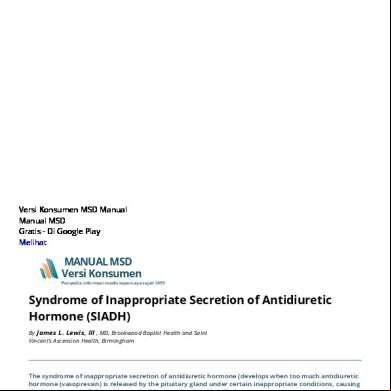Sindrom Sekresi Hormon Antidiuretik (siadh) Yang Tidak Pantas - Gangguan Hormon Dan Metabolik - Manual Msd Versi Konsumen 2b5r6b
This document was ed by and they confirmed that they have the permission to share it. If you are author or own the copyright of this book, please report to us by using this report form. Report 2z6p3t
Overview 5o1f4z
& View Sindrom Sekresi Hormon Antidiuretik (siadh) Yang Tidak Pantas - Gangguan Hormon Dan Metabolik - Manual Msd Versi Konsumen as PDF for free.
More details 6z3438
- Words: 638
- Pages: 3
Versi Konsumen MSD Manual Manual MSD Gratis - Di Google Play Melihat
MANUAL MSD Versi Konsumen
Penyedia informasi medis tepercaya sejak 1899
Syndrome of Inappropriate Secretion of Antidiuretic Hormone (SIADH) By James L. Lewis, III , MD, Brookwood Baptist Health and Saint Vincent’s Ascension Health, Birmingham
The syndrome of inappropriate secretion of antidiuretic hormone (develops when too much antidiuretic hormone (vasopressin) is released by the pituitary gland under certain inappropriate conditions, causing the body to retain uid and lower the blood sodium level by dilution. (See also Overview of Electrolytes and Overview of Sodium's Role in the Body.) Vasopressin (also called antidiuretic hormone) helps regulate the amount of water in the body by controlling how much water is excreted by the kidneys. Vasopressin decreases water excretion by the kidneys. As a result, more water is retained in the body, which dilutes the level of sodium in the body. A low level of sodium is called hyponatremia. The pituitary gland appropriately produces and releases vasopressin when the blood volume (amount of uid in the blood vessels) or blood pressure goes down or when levels of electrolytes (such as sodium) become too high
blood vessels) or blood pressure goes down or when levels of electrolytes (such as sodium) become too high. Secretion of vasopressin is termed inappropriate if it occurs when Blood volume is normal or high Blood pressure is normal or high Electrolyte concentrations are low Other appropriate reasons for vasopressin release are not present When vasopressin is released in these situations, the body retains too much uid, and the sodium level in blood decreases.
Causes Many conditions increase the risk of developing SIADH. SIADH may result when vasopressin is produced outside the pituitary gland, as occurs in some lung and other cancers. SIADH is common among older people and is fairly common among people who are hospitalized. SIADH has a long list of possible causes that typically require additional tests to uncover.
Kue
What Causes SIADH? Type of Disorder
Examples
Abscesses in the brain Bleeding (hemorrhage) within the layers of tissue covering the brain Encephalitis (in ammation of the brain) Brain or Guillain-Barré syndrome nervous Head injury system Hypothalamus disorders, including tumors (rare) Meningitis Strokes Tumors Acute respiratory failure Lung Pneumonia Tuberculosis Brain cancer Lung cancer Cancers Lymphoma Pancreatic cancer Cancer of the small intestine Surgery Other Undernutrition SIADH = syndrome of inappropriate secretion of antidiuretic hormone.
Symptoms Symptoms of SIADH tend to be those related to the low sodium level in blood (hyponatremia) that accompanies it. Symptoms include sluggishness and confusion.
Diagnosis Blood and urine tests Doctors suspect SIADH based on a person’s circumstances and symptoms. Blood and urine tests are done to measure the sodium and potassium levels and to determine how concentrated the blood and urine are (osmolality). Doctors also rule out other possible causes of excess vasopressin (such as pain, stress, drugs, or cancer). Once SIADH is diagnosed, doctors try to identify the cause and address it so the sodium level slowly returns to normal.
Treatment Restriction of uid intake Doctors restrict uid intake and treat the cause if possible. People with SIADH need treatment of hyponatremia for the long term. Intravenous uids, including uids containing very high concentrations of sodium (hypertonic saline), are sometimes given. Such treatments must be given carefully to avoid rapid increases in the sodium level. If the sodium level in blood continues to decrease or does not increase despite restriction of uid intake, doctors may prescribe drugs such as demeclocycline or lithium, which decrease the e ect of vasopressin on the kidneys, or drugs such as conivaptan and tolvaptan, which block vasopressin receptors and prevent the kidneys from responding to vasopressin. Last full review/revision September 2018 by James L. Lewis, III, MD
© 2018 Merck Sharp & Dohme Corp., a subsidiary of Merck & Co., Inc., Kenilworth, NJ, USA)
MANUAL MSD Versi Konsumen
Penyedia informasi medis tepercaya sejak 1899
Syndrome of Inappropriate Secretion of Antidiuretic Hormone (SIADH) By James L. Lewis, III , MD, Brookwood Baptist Health and Saint Vincent’s Ascension Health, Birmingham
The syndrome of inappropriate secretion of antidiuretic hormone (develops when too much antidiuretic hormone (vasopressin) is released by the pituitary gland under certain inappropriate conditions, causing the body to retain uid and lower the blood sodium level by dilution. (See also Overview of Electrolytes and Overview of Sodium's Role in the Body.) Vasopressin (also called antidiuretic hormone) helps regulate the amount of water in the body by controlling how much water is excreted by the kidneys. Vasopressin decreases water excretion by the kidneys. As a result, more water is retained in the body, which dilutes the level of sodium in the body. A low level of sodium is called hyponatremia. The pituitary gland appropriately produces and releases vasopressin when the blood volume (amount of uid in the blood vessels) or blood pressure goes down or when levels of electrolytes (such as sodium) become too high
blood vessels) or blood pressure goes down or when levels of electrolytes (such as sodium) become too high. Secretion of vasopressin is termed inappropriate if it occurs when Blood volume is normal or high Blood pressure is normal or high Electrolyte concentrations are low Other appropriate reasons for vasopressin release are not present When vasopressin is released in these situations, the body retains too much uid, and the sodium level in blood decreases.
Causes Many conditions increase the risk of developing SIADH. SIADH may result when vasopressin is produced outside the pituitary gland, as occurs in some lung and other cancers. SIADH is common among older people and is fairly common among people who are hospitalized. SIADH has a long list of possible causes that typically require additional tests to uncover.
Kue
What Causes SIADH? Type of Disorder
Examples
Abscesses in the brain Bleeding (hemorrhage) within the layers of tissue covering the brain Encephalitis (in ammation of the brain) Brain or Guillain-Barré syndrome nervous Head injury system Hypothalamus disorders, including tumors (rare) Meningitis Strokes Tumors Acute respiratory failure Lung Pneumonia Tuberculosis Brain cancer Lung cancer Cancers Lymphoma Pancreatic cancer Cancer of the small intestine Surgery Other Undernutrition SIADH = syndrome of inappropriate secretion of antidiuretic hormone.
Symptoms Symptoms of SIADH tend to be those related to the low sodium level in blood (hyponatremia) that accompanies it. Symptoms include sluggishness and confusion.
Diagnosis Blood and urine tests Doctors suspect SIADH based on a person’s circumstances and symptoms. Blood and urine tests are done to measure the sodium and potassium levels and to determine how concentrated the blood and urine are (osmolality). Doctors also rule out other possible causes of excess vasopressin (such as pain, stress, drugs, or cancer). Once SIADH is diagnosed, doctors try to identify the cause and address it so the sodium level slowly returns to normal.
Treatment Restriction of uid intake Doctors restrict uid intake and treat the cause if possible. People with SIADH need treatment of hyponatremia for the long term. Intravenous uids, including uids containing very high concentrations of sodium (hypertonic saline), are sometimes given. Such treatments must be given carefully to avoid rapid increases in the sodium level. If the sodium level in blood continues to decrease or does not increase despite restriction of uid intake, doctors may prescribe drugs such as demeclocycline or lithium, which decrease the e ect of vasopressin on the kidneys, or drugs such as conivaptan and tolvaptan, which block vasopressin receptors and prevent the kidneys from responding to vasopressin. Last full review/revision September 2018 by James L. Lewis, III, MD
© 2018 Merck Sharp & Dohme Corp., a subsidiary of Merck & Co., Inc., Kenilworth, NJ, USA)










